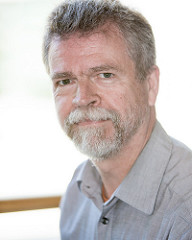Rod Edwards

Position
Credentials
PhD U of Victoria
Contact
My research has involved the analysis of network dynamics arising in biology, including neuronal, genetic, electronic, and disease networks, as well as analysis of physiological time series and applications of mathematics in other areas such as applied linguistics.
Interests
- Gene-regulatory networks
- Neuronal networks
- Biochemical networks
- Piecewise-linear systems
- Differential equations
- Chaos
- Analysis of physiological time series
- Modelling of vocabulary acquisition
- Complex dynamics in analog electronic circuits
Faces of UVic Research video
In this video, Rod talks about his research as an applied mathematician studying networks in a biological context.
Courses
- Fall 2025:
- Spring 2026:
- Summer 2026:
Current Projects
Transcription-translation networks
Simplified models of gene-regulatory networks have often ignored the multiple steps of transcription, translation and post-translational modification, as if proteins regulated each other's production directly. The justification for this has been that transcription is much faster than translation and can thus be taken as instantaneous. I and my colleagues have been involved in assessing the extent to which behaviour differs when transcription and translation are explicitly modelled, so that both mRNA and protein concentrations are system variables, and in extending techniques of analysis developed for the protein-only models to the transcription-translation models.
Modelling the engineering of neural tissue on scaffolds
Bioengineers are attempting to grow neural tissue on biomaterial scaffolds from human induced pluripotent stem cells. Meghan Hall, a graduate student, has been working with me and Stephanie Willerth (who holds a Canada Research Chair in bioengineering) to develop the first comprehensive mathematical model of the process of growth and differentiation, taking into account the dynamics of differentiation and proliferation, including feedback effects, and the effects of contact with the scaffold (depending on the scaffold's porosity), oxygen diffusion through the liquid medium in which the experiment is conducted, oxygen consumption by the cells, and waste (mainly CO2) production by the cells. The model is a simple compartmental ODE system but already accounts for qualitative features of the experiments, and suggests ways to improve the maximal size of the differentiated cell population (neurons) achieved, particularly by conducting the experiment in a reduced-oxygen ambient environment.
Chaotic 'True Random Number Generators'
The equations used to describe qualitative behaviour of genetic networks can also describe the behaviour of analog electronic networks. We can use results from the former to help design better 'True Random Number Generators' of importance in cybersecurity. In particular, chaos in such systems is a useful property for generating entropy from electronic circuits (producing random numbers) and to make them robust to attack.
Selected Publications
- S. Doré-Hall and R. Edwards. Ramp approximations of Michaelis-Menten functions in a model of plant metabolism. Physica D, 442:133544 (2022).
- R. Edwards and M. Wood. Branch prioritization motifs in biochemical networks with sharp activation. AIMS Mathematics, 7:1115-1146 (2022).
- G. Quee and R. Edwards. Ramp approximations of sigmoid control functions in gene networks. Physica D, 418:132840 (2021).
- R. Edwards and A. Maignan. A class of discrete dynamical systems with properties of both cellular automata and L-systems. Natural Computing, 19:609-641 (2020).
- E. Farcot, S. Best, R. Edwards, I. Belgacem, X. Xu and P. Gill. Chaos in a ring circuit. Chaos, 29:043103 (2019).
- Z.P. Adams, J. Ehlting and R. Edwards. The regulatory role of shikimate in plant phenylalanine metabolism. Journal of Theoretical Biology, 462:158-170 (2019).
- R. Edwards. Zeno breaking, the Contact effect and sensititve behaviour in piecewise-linear systems. European Journal of Applied Mathematics, 29:826-844 (2018).
- M. Hall, N.K. Mohtaram, S.M. Willerth and R. Edwards. Modelling the behaviour of human induced pluripotent stem cells seeded on melt electrospun scaffolds. Journal of Biological Engineering, 11:38 (2017).
- S. Odense and R. Edwards. Universal approximation results for the temporal restricted Boltzmann machine and the recurrent temporal restricted Boltzmann machine. Journal of Machine Learning Research, 17:1-21 (2016).
- D. Hudson and R. Edwards. Dynamics of transcription-translation networks. Physica D, 331:102-113 (2016).
- E. Foxall, R. Edwards and P. van den Driessche. Social contact processes and the partner model. Annals of Applied Probability, 26:1297-1328 (2016).
- R. Edwards, A. Machina, G. McGregor and P. van den Driessche. A modelling framework for gene regulatory networks involving transcription and translation. Bulletin of Mathematical Biology, 77:953-983 (2015).
- P. Shahrear, L. Glass and R. Edwards. Chaotic dynamics and diffusion in a piecewise linear equation. Chaos, 25, 033103 (2015).
- T.J. Perkins, E. Foxall, L. Glass and R. Edwards. A scaling law for random walks on networks. Nature Communications, 5:5121 (2014).
